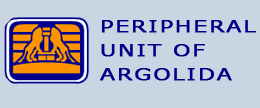Aria
| The Areia or Aria, the nearest village of Nafplio, is located east in a distance of three kilometers. It is the first village on the road Nafplio – Epidaurus, situated at the foot of a hill which is a continuation of the hill of Palamidi. |
||
| The earliest historical reference to the existence of the Aria outpost is met the year 1149 the legend of Leo, Bishop of Argos and Nafplio, indicating that built the Holy Monastery 'in place of Aria ". It seems that in this hill above Aria, resulting groundwater as previously there were at least four major sources of water at various points, with the eponymous major source of Aria and the source of the monastery of the Holy Monastery of Aria dedicated to the Life Giving Spring. | 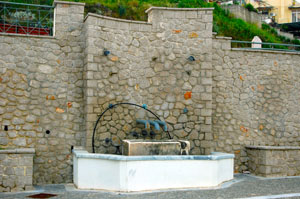 |
|
| The existence of water, which until the 1960s was the main source of water nearby Nafplio, made for this important and necessary so that the history of Aria and their fate is closely linked. | ||
Aria was incorporated in the Municipality of Nafplio on April 4, 1994, before "Kapodistrian" municipality and currently has almost united geographically with Nafplio, while most residents are no longer are farmers, ranchers, artisans and transporters as they were previously and the village has now gained purely civil in nature. In the 2001 census, Aria had 1920 inhabitants, while in recent years expanded around and rebuilt almost all the opposite hill Magoulas (Agios Vlassis) so that the road to Epidaurus divides the village in two, and in three districts Rodiou, St . Kiriaki and Exostis. |
||
| Historical data The region, possibly because of water sources, seems to have been inhabited since ancient years. The Mycenaean tombs which were found near the source of Aria and other traces of Mycenaean structures recently found near the old school, the ancient Greek temple on the ruins of which has been built the Holy Monastery and the Roman aqueduct which supplied it with water from Nafplio are evidence leaving no doubt that the area of Aria had attracted residents long before the earliest historical reference. In the Venetian years, when the first relevant historical recordings appear, Aria was a "suburb" of Nafplio and together with the village Merze (today Exostis) were part of the administrative area of the town of Nafplio. Venetian records of the time stated that Aria had 34 private homes and 110 collapsed public houses. These numbers coincide with the ecclesiastical census of 1696, according to which there were 32 houses. In other census data reported by the French historian and consul Poukevile, Aria in 1814 had 70 inhabitants. Later, the area of Aria played an important role in the revolution of February 1, 1862 against the absolutism of King Othona. In Aria, but also at the surrounding hills of the Prophet Elia and Papafena major battles between the rebels and government forces took place, culminating in the Battle of Aria (1 March 1862) were the hero artillery lieutenant Sp Diovouniotis were killed defending the source water. Today, this part is memorial in his honor. |
||
| Attractions in Aria | ||
| The view The visitor of Aria has a unique view of almost half Argolida plains. Apart from Palamidi and Nafplio lying stretched before him, Mpourtzi is also visible which protected the harbor of Nafplio. |
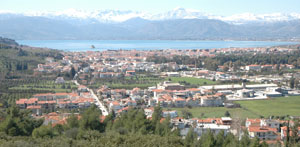 |
|
| Even Argos is visible to Aria, the ancient acropolis (Larissa), Tiryns with the Cyclopean walls, the northern tip of the Argolida Gulf with ancient Lerna and adjacent Kivérion where the summer residences of Franks de-la-Ross were, rulers of Athens and Nafplion. | ||
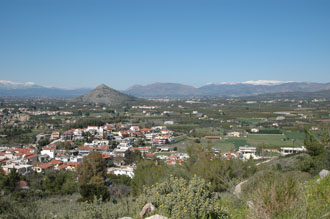 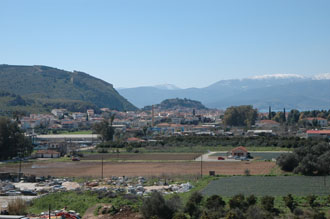 |
||
|
The Kanathos source. Many authors argue that the source of Martian identified with ancient Kanatho source in which the goddess Hera bathed and reacquired virginity. Formerly abundant water run to the sea, but today it runs fewer, and only flows during the winter season. |
||
|
The Holly Monastery Southwest of Aria and within half a mile, lies the Holy Monastery of Aria, which is dedicated to the "life-Containing Fount". The monastery is a shining example of Byzantine architecture rather of the 11th century and it has been erected on the ruins of ancient temple. Many members of the ancient temple have been incorporated into the building of the universal, while at the back side of the building someone can see even today columns and capitals of the ancient temple in soil. In the monastery there is a water source since ancient times. |
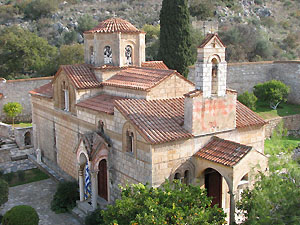 |
|
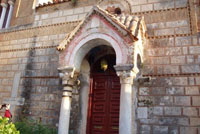 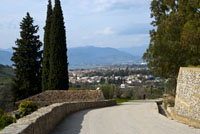 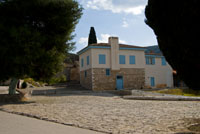 |
||
|
|
||
| Τhe memorial of Sp Diovouniotis
The monument of the hero Lieutenant Artillery Sp Diovouniotis located near the place of his death and the old source. |
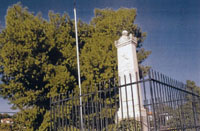 |
|
| The square
In the center of the oldest part of the village is the impressively large square which until 1992 consisted of five large, circular, unevenly, cobbled threshing. Here threshing and winnowing of fruits took place and festivals and major celebrations were performed. Unfortunately, today the paved surfaces of Alonia have been covered and have changed the traditional character of the area. The church, the building of the Cultural Centre and the memorial to the Fallen has been built on the square. |
||
|
Churches and Chapels The central church of Aria dedicated to the "Assumption" is built in 1866 on top of other pre-existing early Christian Byzantine church and it has a magnificent marble temple that was built in 1893. On the north side of the village, at the top of the hill Magoula, there is the church of the patron saint of Aria, Saint Vasilios, a small basilica with a flat roof. Although Saint Vlassis built in the late 19th century, it is certain that there a Christian church existed, since the top of the hill noting the existence of a church in Venetian topographic 1714. |
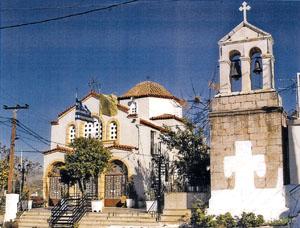 Church of Assumption of Virgin Mary
|
|
| The area has several interesting smaller churches and chapels with old paintings such as Agia Kyriaki, of St. Eleftherios, Agia Paraskevi, May Thanasis, St Theodosius etc. | ||
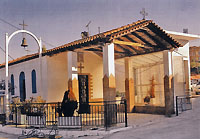 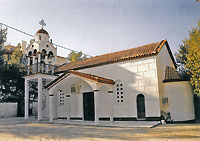  Agia Eleousa Agioi Anargiri St Theodosius |
||
|
Exostis In a distance of a kilometre from Aria, is the area of Exostis. The settlement primarily was called Merzes and it was populated by the Venetians, stated as Zevgolatio Merze. At Exostis, one of the first pharmacists who came in liberated Greece and friend of Governor Ioannis Kapodistrias Boniface Vonafin had his property. Vonafin opened its first pharmacy in Greece and soused, the deceased Ioannis Kapodistrias. |
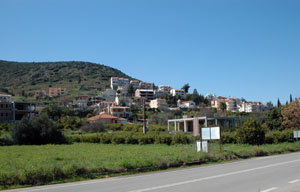 |
|
| At the estate of the Vonafin the church of doctors Anargiron Saints Kosmas and Damian were built. Exostis is built amphitheatricallly and the last decade it has high residential development because of the panoramic view. | ||
 |
||
| Square of Aria (Lat: 37.570990115453725, Long: 22.830147743225098) | ||



